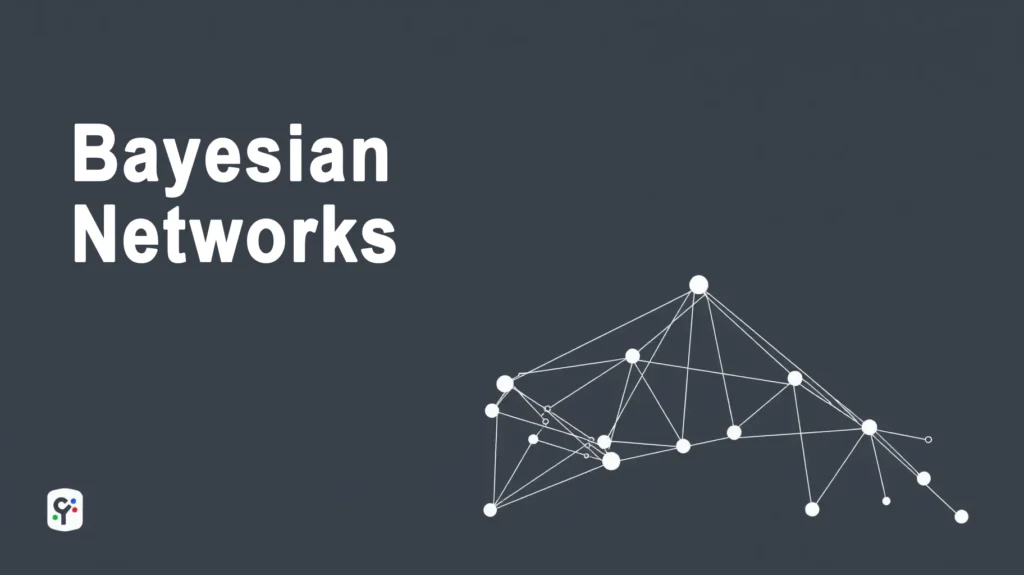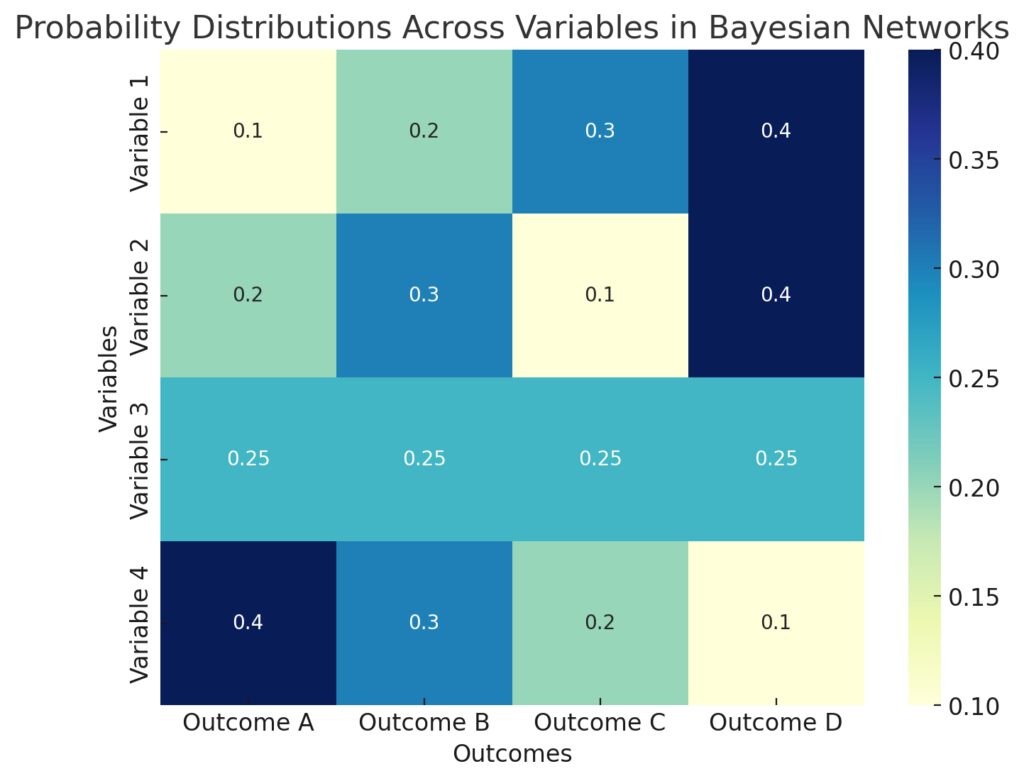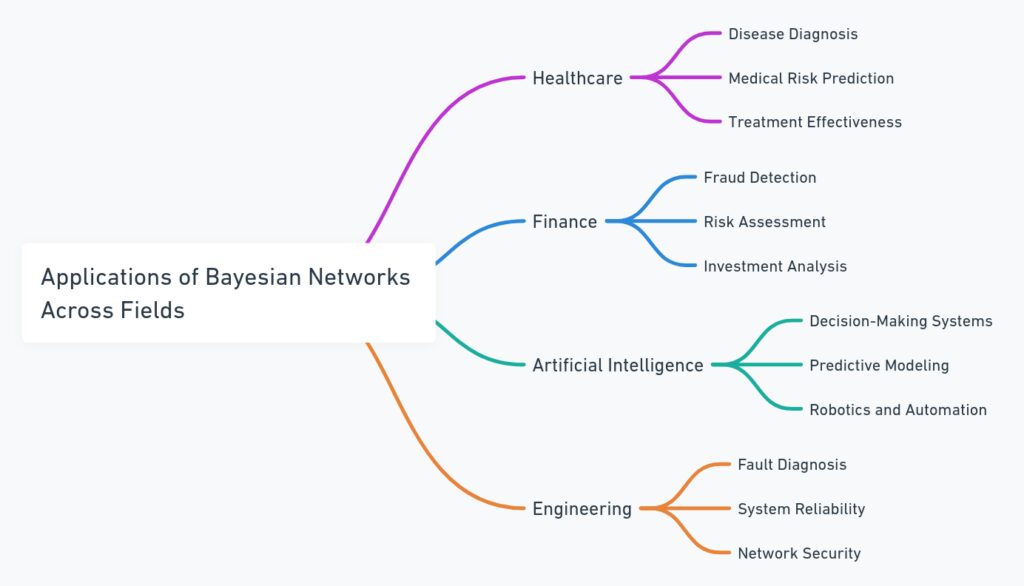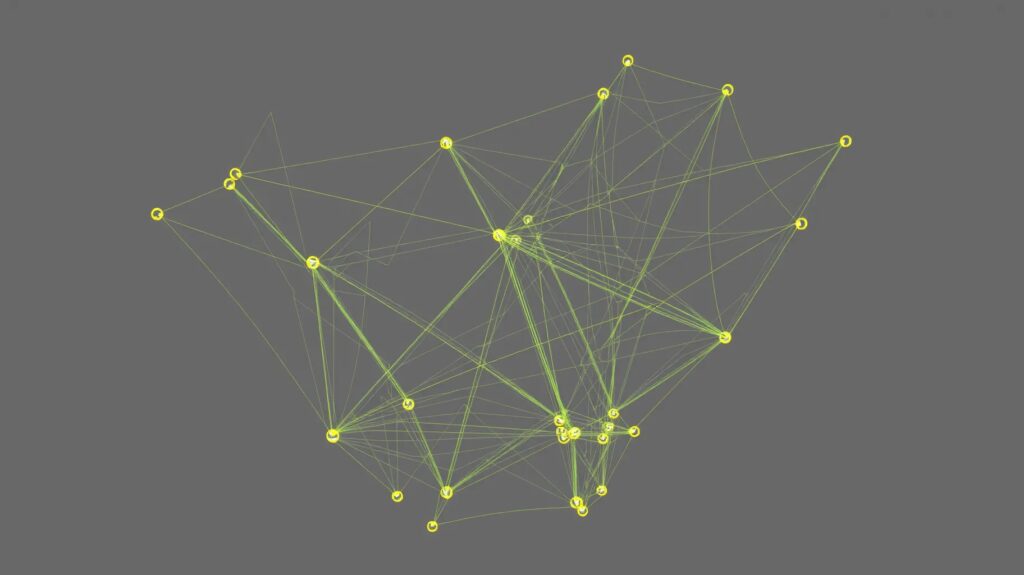
Bayesian Networks: The Underexplored Potential in Complex Systems Analysis
The realm of complex systems analysis is vast and intricate. Whether you’re studying biological ecosystems, financial markets, or even artificial intelligence, these systems often have countless variables influencing each other.
One tool stands out for its ability to model and make sense of this complexity: the Bayesian Network. But despite its potential, it’s often underutilized. Let’s dive into the underexplored promise of Bayesian Networks in solving some of today’s most challenging problems.
How Bayesian Networks Mimic Real-World Systems

Bayesian Networks are not just another tool for data analysis. They provide a graphical representation of probabilistic relationships. Imagine a set of interconnected variables, where each node represents a variable, and the edges between them represent dependencies or cause-effect relationships. This setup mirrors real-world scenarios.
For instance, in healthcare, symptoms might point to different possible diseases. Using a Bayesian Network, we can model these symptoms and map them to potential causes in a probabilistic framework. This gives us a more nuanced approach than simple diagnostic methods.
Such networks allow for uncertainty, which is crucial when dealing with incomplete or noisy data—something we often encounter in complex systems.
Solving Multi-Dimensional Problems
When you’re faced with systems that involve multiple dimensions, trying to model them can feel overwhelming. But this is where Bayesian Networks shine. They let you break down the problem into smaller, more manageable parts. By doing this, you can focus on individual relationships while still seeing how everything fits together.
In fields like artificial intelligence, Bayesian Networks are especially useful for decision-making under uncertainty. Whether it’s a self-driving car needing to predict the behavior of pedestrians, or an AI algorithm trying to optimize financial portfolios, the ability to map out potential outcomes with probabilities can lead to smarter, more robust systems.
Additionally, these networks are flexible, meaning they can evolve over time as new data becomes available, adapting to the changing environment of the system they are modeling.
The Role of Bayesian Networks in Machine Learning
While machine learning has taken the world by storm, Bayesian Networks remain somewhat of an underdog. Yet, when integrated with machine learning models, they offer a more transparent approach to understanding relationships in data.
One common critique of machine learning models is that they often act as black boxes. You feed in data, and you get predictions, but the inner workings can be opaque. With Bayesian Networks, however, there’s more clarity. They allow us to see and understand how variables influence each other and how changes in one part of the system ripple through the entire network.
For example, in image recognition, a Bayesian Network could help us understand not just what the machine is identifying in an image, but why it’s reaching that conclusion. By breaking down the decision-making process, researchers can tweak models for better accuracy and robustness.

Improving Decision-Making in Business and Finance
In business, making decisions based on incomplete information is often the norm. Whether it’s choosing an investment strategy or deciding on a marketing campaign, uncertainty looms large. Bayesian Networks can play a pivotal role here, providing businesses with a way to model risk and make more informed decisions.
For example, imagine a company trying to decide whether to launch a new product. With Bayesian Networks, they can factor in various variables like market trends, customer preferences, and competitor behavior to estimate the likelihood of success. This allows them to make decisions based on probabilities, rather than gut instinct alone.
| Variable | Condition | Probability (%) |
|---|---|---|
| High Sales Demand | Market trending up | 70% |
| High Sales Demand | Market trending down | 40% |
| High Sales Demand | Competitor price increases | 65% |
| High Sales Demand | Competitor price decreases | 30% |
| High Customer Satisfaction | Market trending up | 85% |
| High Customer Satisfaction | Market trending down | 60% |
| Successful Product Launch | High sales demand & high satisfaction | 90% |
| Successful Product Launch | High sales demand & low satisfaction | 50% |
| Successful Product Launch | Low sales demand & high satisfaction | 40% |
| Successful Product Launch | Low sales demand & low satisfaction | 10% |
The finance industry, in particular, has begun tapping into the predictive capabilities of Bayesian Networks. By modeling market behavior and various risk factors, financial analysts can anticipate future trends and identify investment opportunities with higher levels of confidence.
Tackling Environmental and Ecological Challenges
The environment is one of the most complex systems we face today. Climate change, biodiversity loss, and natural resource depletion are all interconnected issues with multiple influencing factors. Bayesian Networks offer an approach to capture these interdependencies and model different scenarios.
For instance, environmental scientists use these networks to model the impact of various factors on ecosystems. By inputting data related to pollution levels, land use, and species behavior, they can simulate different environmental outcomes and develop more targeted conservation strategies.
Additionally, when dealing with sustainability initiatives, companies and governments can use Bayesian Networks to weigh the potential outcomes of different policies or actions, factoring in both short-term and long-term consequences.

Enhancing Predictive Analytics in Healthcare
Predicting health outcomes is another area where Bayesian Networks are poised to make a huge impact. With the growing amount of personal health data, from wearable devices to electronic health records, making sense of it all can be daunting. But by applying Bayesian Networks, healthcare professionals can make more accurate predictions.
For instance, a patient’s data on cholesterol levels, family history, and lifestyle habits can be modeled together in a network to estimate their risk of developing cardiovascular disease. This enables personalized treatments, preventive care strategies, and more efficient healthcare systems overall.
Moreover, in situations where data is scarce, such as with rare diseases, Bayesian Networks excel by integrating knowledge from different sources and extrapolating useful insights.
Modeling Human Behavior and Psychology
One of the most fascinating areas for Bayesian Networks is the analysis of human behavior. Human decision-making is incredibly complex, often driven by subconscious factors, emotions, and external influences. Bayesian Networks can help psychologists and sociologists better understand these processes.
By mapping out the relationships between different behavioral variables, researchers can model how a person might react in various situations. For instance, in consumer psychology, companies can use Bayesian Networks to predict customer decisions, allowing for more targeted and personalized marketing efforts.
Furthermore, Bayesian Networks can be employed in public health campaigns to anticipate how people will respond to certain messages, helping craft more effective outreach programs.
Optimizing Supply Chains and Logistics
One of the most practical and impactful applications of Bayesian Networks lies in the optimization of supply chains. Modern supply chains are complex, involving numerous stakeholders, from manufacturers and suppliers to distributors and retailers. They are also vulnerable to uncertainties, such as delays, demand fluctuations, and external disruptions.
By using Bayesian Networks, companies can model their entire supply chain, factoring in all these uncertainties. This allows them to predict potential bottlenecks or risks, such as shortages in raw materials or delivery delays. When unforeseen events occur, such as a natural disaster disrupting a key supplier, the network can be quickly updated to reflect the new probabilities, allowing businesses to adapt more effectively and swiftly.
Moreover, the interdependencies between different variables, such as shipping times and production capacity, are often difficult to quantify with traditional methods. Bayesian Networks simplify this by visually representing the causal links between these factors, providing a more intuitive way for decision-makers to manage and adjust logistics plans on the go.

Strengthening Cybersecurity Through Risk Modeling
In an era where cyber threats are constantly evolving, companies need advanced tools to assess and mitigate these risks. Bayesian Networks provide a framework to model cyber threats by representing potential vulnerabilities, attack vectors, and the relationships between them.
For instance, in a corporate network, there could be dozens of entry points for a cyberattack, including employees’ devices, cloud services, and internal servers. By using Bayesian Networks, security teams can model the likelihood of a breach at each point, based on historical data, threat intelligence, and current security measures. This allows them to focus resources on the most vulnerable areas.
Furthermore, Bayesian-based models can dynamically update as new threats emerge. If a new vulnerability is discovered in a widely used software application, the network can immediately adjust its probabilities, giving security teams real-time insights into how this affects their overall risk landscape.
Improving Weather Forecasting and Climate Models
Accurate weather forecasting is notoriously difficult due to the sheer number of variables involved, from atmospheric pressure to wind patterns and ocean currents. Bayesian Networks have the potential to enhance weather predictions by modeling the relationships between these variables and updating forecasts as new data becomes available.
In fact, some meteorologists already use Bayesian Networks to combine historical data with real-time observations, improving the accuracy of short-term weather forecasts. By using this approach, they can better predict extreme weather events, such as hurricanes or droughts, by understanding how specific conditions influence the likelihood of these occurrences.
Beyond daily weather, climate change models can also benefit from the flexibility of Bayesian Networks. As researchers gather more data on factors like carbon emissions and deforestation, Bayesian models can evolve to provide better long-term predictions. This helps policymakers create more effective strategies for mitigating climate impacts.
Revolutionizing Natural Language Processing (NLP)
In the world of natural language processing (NLP), Bayesian Networks offer an elegant way to handle the ambiguity and uncertainty inherent in human language. Whether it’s speech recognition, translation, or text generation, NLP models often need to account for multiple interpretations of a phrase or sentence.
By incorporating Bayesian inference into NLP algorithms, developers can model the relationships between words, sentences, and broader contexts. This helps the system make more accurate guesses when dealing with ambiguous text. For example, if a chatbot is unsure of a user’s intent, it can use Bayesian Networks to weigh different possibilities and respond in a more contextually appropriate manner.
Additionally, Bayesian Networks are particularly useful in machine translation, where context and word meaning can vary significantly between languages. These networks enable the system to consider different translations and pick the one with the highest probability of being correct, resulting in more natural-sounding translations.
Facilitating Smart City Development
As cities grow and become more interconnected, smart city initiatives are gaining momentum. These projects aim to improve urban living through the use of technology, such as IoT sensors, AI, and data analytics. Bayesian Networks can play a critical role in managing urban complexity by modeling various aspects of city life, from traffic flow to energy consumption.
For instance, a smart traffic system could use a Bayesian Network to model the relationship between traffic patterns, weather conditions, and road construction. By continuously updating the model with real-time data, city planners can predict and alleviate congestion before it happens, improving overall urban mobility.
In addition, public safety systems in smart cities can leverage Bayesian Networks to predict and prevent incidents like power outages, water shortages, or even crime. By analyzing patterns from multiple data sources, cities can better allocate resources and respond more proactively to potential problems.
[Video: “Bayesian Networks in Smart City Development” – October 15, 2023] This video discusses how Bayesian Networks are being integrated into smart city initiatives, with a focus on optimizing traffic management and improving sustainability in urban environments.
Streamlining Legal Decision-Making
Legal systems often deal with uncertain outcomes. Judges and lawyers must weigh evidence, precedents, and the potential implications of their decisions. Bayesian Networks can be used to model legal cases, helping professionals evaluate different possible outcomes based on the evidence at hand.
For example, in a criminal trial, a Bayesian Network can represent the probability of a defendant’s guilt based on various pieces of evidence, such as witness testimony, forensic data, and prior convictions. This helps legal professionals make more informed decisions, considering both direct and indirect evidence.
Beyond courtroom decisions, Bayesian Networks can assist in predictive justice, such as forecasting the likelihood of recidivism or the success of rehabilitation programs. By analyzing factors like prior offenses, social environment, and psychological profiles, these networks can guide policymakers in creating more effective criminal justice policies.
Bayesian Networks, with their unique ability to represent complex relationships and uncertainties, have immense potential across a variety of fields. Whether optimizing supply chains, strengthening cybersecurity, or transforming weather forecasting, the impact of this tool is far-reaching. Its flexibility and adaptability make it an essential tool for future problem-solving across industries.
FAQs
How do Bayesian Networks differ from other data models?
Bayesian Networks differ from traditional models in that they explicitly represent dependencies between variables, whereas other models often assume independence. They are unique in their ability to handle uncertainty and update predictions dynamically as new information arrives, making them more adaptable than fixed, deterministic models.
What are the key applications of Bayesian Networks?
Bayesian Networks have a wide range of applications, including:
- Healthcare: Diagnosing diseases and predicting outcomes.
- Machine Learning: Enhancing decision-making models and improving prediction transparency.
- Finance: Risk modeling and investment strategy development.
- Supply Chain Management: Optimizing logistics and forecasting disruptions.
- Cybersecurity: Predicting breaches and identifying system vulnerabilities.
Why are Bayesian Networks considered underutilized?
Despite their significant potential, Bayesian Networks are often underutilized due to the specialized knowledge required to build and interpret them. Many industries are also unaware of how effective they can be in solving complex problems, although awareness is growing with the rise of data science.
Can Bayesian Networks handle big data?
Yes, Bayesian Networks can handle large datasets, though they may require advanced algorithms to manage the complexity. They are particularly effective at integrating data from multiple sources and making informed predictions even when the data is incomplete or noisy, which makes them valuable tools in big data analytics.
How are Bayesian Networks used in machine learning?
In machine learning, Bayesian Networks model relationships between variables, making the decision-making process more transparent. This is especially valuable for explaining complex AI predictions, such as in healthcare or finance, where understanding the “why” behind predictions is as important as the outcomes themselves.
What is the biggest advantage of using Bayesian Networks?
The major advantage of Bayesian Networks is their ability to work with uncertainty. They allow for predictions and decisions to be made even with incomplete or ambiguous data, providing dynamic and updated probabilities that reflect new information in real-time.
Can Bayesian Networks be integrated with other AI technologies?
Yes, Bayesian Networks can be integrated with other AI technologies, such as deep learning. This combination can improve interpretability in systems like image recognition or natural language processing, where understanding relationships between inputs is critical.
What are the limitations of Bayesian Networks?
Bayesian Networks have several limitations, including:
- Complexity: Building accurate networks for large systems can be difficult.
- Data Dependency: They require accurate data to function properly. Incomplete or inaccurate data can distort the results.
- Computation: Large Bayesian Networks may require significant computational resources, especially when calculating complex probability distributions.
How are Bayesian Networks useful in environmental science?
In environmental science, Bayesian Networks are used to model ecosystem interactions and predict environmental changes, such as climate change impacts. They are especially valuable in integrating diverse data sources, allowing scientists to create more holistic models for forecasting long-term changes in ecosystems.
What kind of data is needed to create a Bayesian Network?
To create a Bayesian Network, you need both quantitative data, such as probabilities or numerical values, and qualitative data, such as expert opinions or historical records. The accuracy of the data directly affects the reliability of the predictions made by the network.
How do Bayesian Networks handle missing or incomplete data?
One of the key strengths of Bayesian Networks is their ability to work with incomplete data. They use the existing relationships between variables to infer the likely values of missing data points, ensuring that predictions remain as accurate as possible even with gaps in the data.
What is a practical example of Bayesian Networks in business?
In business, Bayesian Networks are often used for forecasting and decision-making. For example, a retail company might use a Bayesian Network to predict product demand by analyzing market trends and customer behavior. This allows the company to optimize inventory and avoid overstocking or stockouts.
What is the biggest challenge in building Bayesian Networks?
The most significant challenge is defining the structure of the network accurately, which requires expert knowledge of the domain. Additionally, gathering reliable data and computing complex probability distributions, particularly in large-scale systems, can be resource-intensive.
How do Bayesian Networks help in decision-making?
Bayesian Networks assist in decision-making by allowing users to evaluate different possible outcomes based on available data and probabilities. They can calculate the likelihood of various scenarios, helping decision-makers understand the risks and rewards associated with each option. This is especially useful when dealing with complex systems where uncertainty is a major factor.
For example, in finance, a Bayesian Network can help an investor evaluate the probabilities of different market movements and guide investment decisions based on predicted outcomes.
Can Bayesian Networks be used in real-time systems?
Yes, Bayesian Networks can be applied to real-time systems. By continuously updating as new data comes in, they adjust the probabilities of different outcomes. This makes them highly useful in fields like autonomous systems (e.g., self-driving cars) or predictive maintenance, where conditions are constantly changing and decisions must be made on-the-fly.
For example, a self-driving car could use Bayesian Networks to evaluate traffic conditions, adjust for obstacles, and decide the safest route in real time.
How do Bayesian Networks handle uncertainty?
Bayesian Networks are designed to work with uncertainty. Instead of relying on definite outcomes, they assign probabilities to different scenarios, allowing decision-makers to consider the likelihood of various events. This is particularly useful when data is incomplete or ambiguous, as the network can still make informed predictions based on the available evidence.
For instance, in medical diagnostics, Bayesian Networks can model the probability of different diseases based on symptoms, even when not all information is available.
What are some challenges in interpreting Bayesian Networks?
Interpreting Bayesian Networks can be difficult, particularly for those unfamiliar with probability theory. While the visual representation of variables and dependencies is intuitive, the underlying mathematical computations can be complex. Additionally, understanding how conditional probabilities work within the network requires some expertise.
Moreover, it can be challenging to validate the network’s predictions, especially when dealing with systems that involve uncertain or incomplete data.
Are Bayesian Networks static or dynamic?
Bayesian Networks can be both static and dynamic. In a static Bayesian Network, the relationships between variables remain constant. However, in a dynamic Bayesian Network (DBN), the network evolves over time, updating probabilities as new data comes in. This allows DBNs to model time-series data or processes that change over time, making them ideal for real-time decision-making and systems that must adapt to changing conditions.
For example, in climate modeling, a dynamic Bayesian Network can update its predictions as more climate data becomes available, providing more accurate forecasts over time.
How are Bayesian Networks constructed?
Building a Bayesian Network involves defining both the structure (how the variables are connected) and the conditional probabilities (the likelihood of one variable given the state of another). This process typically requires both domain knowledge to understand the relationships between variables and statistical methods to compute the probabilities.
The construction process usually involves:
- Defining nodes for each variable.
- Establishing connections between variables that have causal or dependent relationships.
- Assigning probabilities to each connection based on data or expert input.
Resources
Books
- “Bayesian Networks and Decision Graphs” by Finn V. Jensen and Thomas Nielsen
- This comprehensive book covers the foundations and applications of Bayesian Networks in decision-making and complex systems. It is an excellent resource for beginners and those looking to apply these concepts in real-world scenarios.
- “Bayesian Networks: With Examples in R” by Marco Scutari and Jean-Baptiste Denis
- This book provides practical examples using the R programming language, making it perfect for those interested in both the theory and implementation of Bayesian Networks.
- “Probabilistic Graphical Models: Principles and Techniques” by Daphne Koller and Nir Friedman
- A foundational text for understanding probabilistic models, including Bayesian Networks. It is a more advanced resource, but essential for those looking to dive deep into the technical aspects.
Research Papers
- “Bayesian Networks in Artificial Intelligence” by Heckerman D. (1995)
- This influential paper discusses the use of Bayesian Networks in AI, offering a historical perspective on how they’ve developed and where they’re headed. It’s great for understanding the application in machine learning.
- “Learning Bayesian Networks: Approaches and Challenges” by Constantin F. Aliferis et al. (2010)
- This paper provides insights into the different methods for learning the structure and parameters of Bayesian Networks, offering a deeper dive into how these networks are built from data.
- “Bayesian Networks for Environmental Modeling: Advantages and Limitations” by Uusitalo L. (2007)
- This research paper focuses on using Bayesian Networks for environmental science applications, exploring both their advantages and limitations when it comes to ecosystem modeling and prediction.
Websites & Tutorials
- BNLearn: The Bayesian Networks Repository
- This site offers resources, software, and documentation for working with Bayesian Networks, especially using the popular BNLearn R package. It’s an excellent resource for both beginners and experienced practitioners.
- Machine Learning Mastery: Bayesian Networks Explained
- A beginner-friendly overview of Bayesian Networks, this tutorial explains their use in machine learning and provides practical examples of how to build and use them.
- Coursera: Probabilistic Graphical Models Specialization
- Offered by Stanford University, this series of courses provides an in-depth exploration of probabilistic graphical models, including Bayesian Networks. Perfect for those looking to build a strong theoretical foundation.